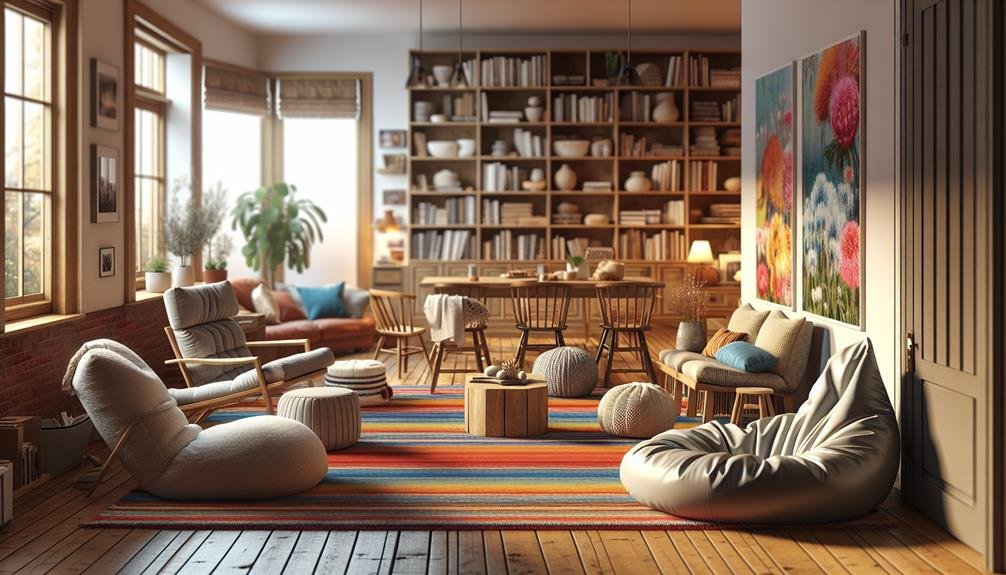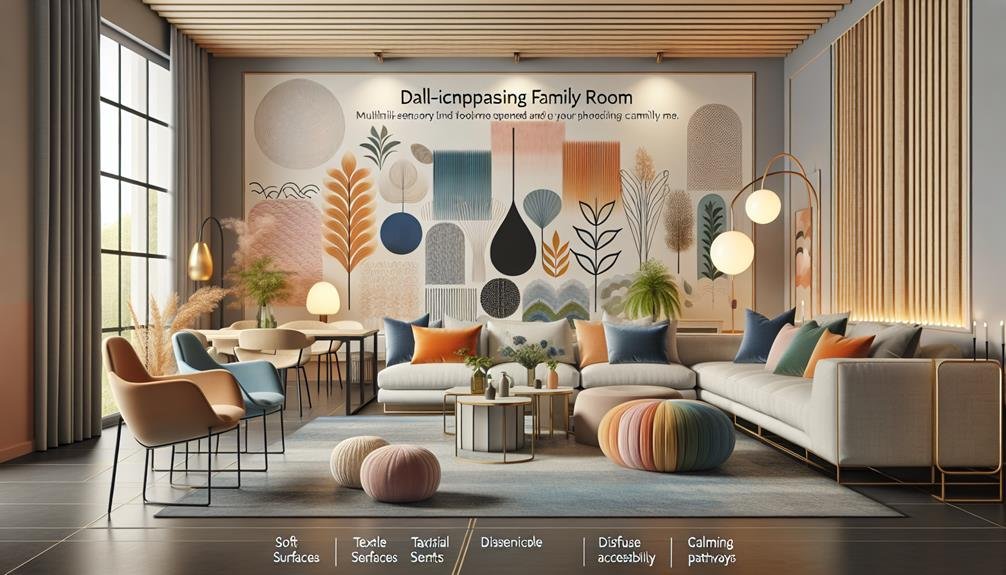When it comes to designing a family room that caters to the diverse needs and preferences of all family members, attention to detail is key.
From selecting furniture arrangements that promote functionality to incorporating lighting solutions that enhance accessibility, there are numerous factors to consider.
The careful selection of inclusive seating options and a thoughtful color palette can significantly impact the room's ambiance. Moreover, integrating multi-sensory design elements adds an extra layer of depth to the space.
By exploring these aspects further, one can uncover a wealth of innovative ideas that truly transform a family room into a harmonious and inclusive environment.
Key Takeaways
- Strategic furniture placement and built-in cabinets create defined zones for organization and space maximization.
- Enhanced lighting solutions, including motion-sensor and smart lighting, cater to diverse needs and preferences for accessibility.
- Inclusive seating arrangements with varied options like modular sofas and floor cushions promote comfort and inclusivity.
- An accessible color palette and multi-sensory design features cater to different sensory needs for a harmonious family room experience.
Functional Furniture Arrangement
When designing a family room, strategic placement of furniture is essential to create functional living spaces that cater to various activities and promote interaction among family members. One effective way to achieve this is by incorporating built-in cabinets into the room layout. Built-in cabinets not only provide ample storage solutions but also help in defining specific zones within the family room.
By strategically placing built-in cabinets, you can create distinct areas for different activities such as a gaming corner, a study nook, or a display area for family photographs and decor. These cabinets can also serve as a functional divider between the seating area and other spaces in the room, helping to optimize the flow of movement and accessibility within the family room.
Moreover, built-in cabinets offer a seamless and streamlined look, contributing to a cohesive design aesthetic while maximizing space utilization. When combined with other furniture pieces like sofas, armchairs, and coffee tables, built-in cabinets help in organizing the room effectively and creating a harmonious atmosphere for family members to enjoy.
Lighting Solutions for Accessibility
Enhancing accessibility in family room design can be achieved through thoughtful implementation of tailored lighting solutions. One effective approach is to consider installing motion-sensor lighting, which can greatly assist individuals with mobility challenges in navigating the space effortlessly.
Additionally, incorporating smart lighting systems into the design can offer enhanced accessibility by allowing remote control or voice commands for adjusting the lights. This feature can be particularly beneficial for individuals with limited mobility or reach.
To further cater to specific needs, it is essential to ensure proper task lighting in key areas such as reading nooks or workspaces, especially for individuals with visual impairments. Adjustable lighting options should also be integrated to accommodate the varying preferences and requirements of different family members.
Inclusive Seating Options

Considering a diverse range of seating options is crucial for creating an inclusive and welcoming family room environment that caters to the varied preferences and needs of its occupants. To achieve this, it is essential to incorporate a mix of seating options such as sofas, loveseats, armchairs, and ottomans.
By including seating with varying heights and depths, you can accommodate individuals with different mobility or comfort requirements. Opting for modular or sectional sofas allows for flexible seating arrangements to accommodate different group sizes. Moreover, integrating seating with varying levels of firmness and support can cater to individuals with diverse comfort preferences.
Adding floor cushions, bean bags, or oversized pillows provides additional seating options that can be easily moved around for a more inclusive setup. By offering a variety of seating choices, you can ensure that your family room is inclusive and comfortable for all occupants, promoting a sense of belonging and relaxation. Remember to consider the Privacy Policy when selecting seating options to respect the personal space and comfort of each individual.
Color Palette for All Abilities
To ensure an inclusive and accommodating family room environment, selecting a color palette tailored to cater to a variety of abilities is essential. When choosing a color palette for a family room, consider the needs of individuals with different abilities.
For those with visual impairments, opt for a color palette with high color contrast to aid in distinguishing between different elements in the room. Individuals with sensory sensitivities may benefit from soothing and calming color combinations that create a relaxing atmosphere. It's important to select colors that are easy to differentiate for those with color vision deficiencies, ensuring that the room remains accessible to all.
Matte finishes can help reduce glare and improve visibility for individuals with light sensitivity. Additionally, incorporating tactile elements such as textured walls or fabrics can cater to individuals with tactile sensitivities, creating a multi-dimensional experience within the space.
Multi-Sensory Design Elements

Imbue your family room with a rich tapestry of sensory experiences by strategically incorporating various textures, scents, and visual elements. To create a multi-sensory design that caters to all family members, consider the following elements:
- Soft Textures: Integrate plush rugs, cozy blankets, and velvet throw pillows to provide tactile sensory input, creating a warm and inviting atmosphere.
- Aromatherapy: Utilize scented candles, essential oil diffusers, or potpourri to introduce pleasant aromas that can enhance relaxation and comfort within the space.
- Varied Upholstery: Include a mix of textures in furniture upholstery, such as smooth leather, soft velvet, or rough woven fabrics, to appeal to different tactile preferences.
- Visual Stimulation: Enhance the room with a water feature like a tabletop fountain or aquarium to provide soothing visual and auditory stimulation, promoting a sense of tranquility and serenity.
Frequently Asked Questions
What Is the Difference Between a Rec Room and a Family Room?
A rec room, akin to a vibrant playground, focuses on leisure activities and informal decor. In contrast, a family room is a cozy haven designed for relaxation, entertainment, and family gatherings, promoting comfort and bonding.
What Do You Put on Each Side of a TV Stand?
When designing around a TV stand, consider adding matching bookshelves or cabinets for storage and visual appeal. Enhance the space with decorative items like vases or plants on one side, and balance the lighting with a floor or table lamp on the other.
What Is the Difference Between a Living Room and a Family Room?
The difference between a living room and a family room lies in their intended function and ambiance. Living rooms are formal spaces for entertaining, while family rooms offer a more relaxed environment for daily activities and family bonding.
What Is Southern Living Style?
Southern Living style embodies a blend of traditional and modern elements, featuring warm earthy tones, natural materials, and cozy textures. It exudes hospitality and charm, creating a welcoming and relaxed atmosphere perfect for family gatherings, reflecting the essence of Southern culture.


